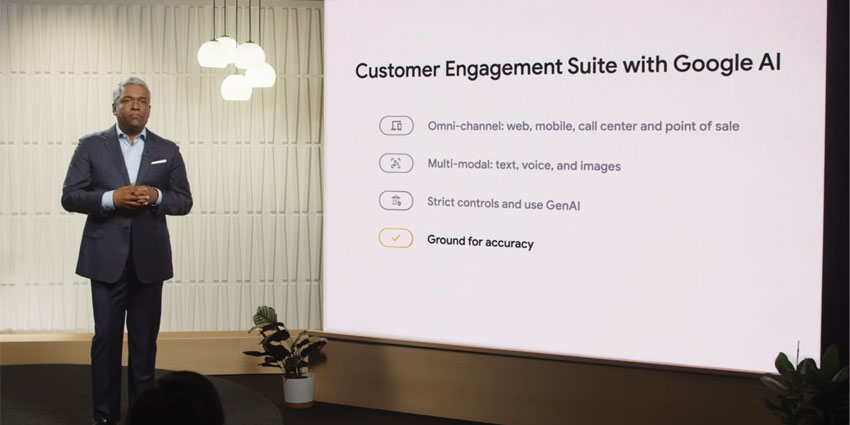Google has introduced a new contact center solution: the Customer Engagement Suite with Google AI.
This announcement was made at the Gemini at Work event, where Google detailed its integration of CCaaS and Conversational AI within a single suite. The suite utilizes Gemini 1.5 Flash, the latest version of Google’s large language model (LLM), to provide embedded GenAI capabilities. By leveraging this first-party LLM, Google aims to enhance contact center teams’ efficiency and reduce costs through faster GenAI innovations.
Additionally, the suite supports a variety of third-party applications, including CRM, WEM, and telephony solutions, and enables a bring-your-own-telephony (BYOT) model.

Key Features of the Google Customer Engagement Suite
In celebrating the launch, Duncan Lennox, VP & GM of Applied AI at Google Cloud, emphasized that generative AI is adding significant value to customer service operations. He mentioned that the new application extends beyond core customer experience hubs to wherever service occurs—be it in-store, on-site, or even at drive-thrus.
Google distinguishes its suite with four main features:
Blended Omnichannel Journeys
Contact centers can create workflows that switch between channels, maximizing the strengths of each.
Multimodal Experiences
The suite supports seamless sharing of text, images, and audio between customers and agents. For instance, a telephone company can request an image of a phone during a call, analyze it for damage, and provide a relevant trade-in offer using voice.
Rule- and GenAI-Based Workflows
Customers can create both deterministic and generative workflows. For example, a bank may need to follow specific legal questions for customer verification (KYC) while also using GenAI to compare mortgage products based on customer inquiries.
Grounded GenAI
The suite allows for high accuracy in Conversational Agents and Agent Assist products, enhancing overall service quality.
Strategic Vision and Future Directions
Google’s vision incorporates an intent-led orchestration approach, meeting customers on their preferred channels and guiding them to the most effective solutions. This strategy aims to leverage modern smartphone capabilities while simplifying the creation of new customer journeys.
The BYOT approach also facilitates the construction of omnichannel experiences, allowing Google to prioritize optimal customer journeys over traditional telephony setups.
However, Google has yet to fully centralize this into a cohesive customer journey orchestration solution, which could limit its effectiveness. This presents an opportunity for further development.
Additionally, Google may need to enhance its marketing strategies for its CX offerings. Despite recent successes, the industry still largely associates Google with its older Contact Center AI Suite, which could hinder the visibility of the innovative Customer Engagement Suite.
New Offering: Vertex AI Search
In tandem with the Customer Engagement Suite, Google also unveiled Vertex AI Search. This solution employs the same technologies behind Google Search to help businesses better understand customer queries. According to Kurian, early adopters in retail have experienced significant improvements in click-through rates, conversion rates, and overall revenue returns.
As Google rolls out the Customer Engagement Suite with Google AI, it represents a significant shift in how contact centers and BPOs can leverage advanced technologies to enhance customer interactions. With its focus on blended omnichannel journeys, multimodal experiences, and the integration of GenAI capabilities, this new offering has the potential to transform operational efficiency and customer satisfaction.
We invite contact centers and BPOs to share their thoughts on this development. How do you envision integrating these innovations into your existing workflows? What challenges or opportunities do you foresee as you adapt to these advanced AI-driven solutions? Your insights will be invaluable in understanding the impact of this technology on the industry.

















+ There are no comments
Add yours